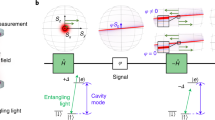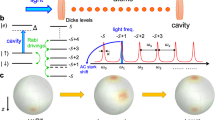Abstract
Quantum metrology uses quantum entanglement—correlations in the properties of microscopic systems—to improve the statistical precision of physical measurements1. When measuring a signal, such as the phase shift of a light beam or an atomic state, a prominent limitation to achievable precision arises from the noise associated with the counting of uncorrelated probe particles. This noise, commonly referred to as shot noise or projection noise, gives rise to the standard quantum limit (SQL) to phase resolution. However, it can be mitigated down to the fundamental Heisenberg limit by entangling the probe particles. Despite considerable experimental progress in a variety of physical systems, a question that persists is whether these methods can achieve performance levels that compare favourably with optimized conventional (non-entangled) systems. Here we demonstrate an approach that achieves unprecedented levels of metrological improvement using half a million 87Rb atoms in their ‘clock’ states. The ensemble is 20.1 ± 0.3 decibels (100-fold) spin-squeezed via an optical-cavity-based measurement. We directly resolve small microwave-induced rotations 18.5 ± 0.3 decibels (70-fold) beyond the SQL. The single-shot phase resolution of 147 microradians achieved by the apparatus is better than that achieved by the best engineered cold atom sensors despite lower atom numbers2,3. We infer entanglement of more than 680 ± 35 particles in the atomic ensemble. Applications include atomic clocks4, inertial sensors5, and fundamental physics experiments such as tests of general relativity6 or searches for electron electric dipole moment7. To this end, we demonstrate an atomic clock measurement with a quantum enhancement of 10.5 ± 0.3 decibels (11-fold), limited by the phase noise of our microwave source.
This is a preview of subscription content, access via your institution
Access options
Subscribe to this journal
Receive 51 print issues and online access
$199.00 per year
only $3.90 per issue
Buy this article
- Purchase on Springer Link
- Instant access to full article PDF
Prices may be subject to local taxes which are calculated during checkout




Similar content being viewed by others
References
Giovannetti, V., Lloyd, S. & Maccone, L. Quantum-enhanced measurements: beating the standard quantum limit. Science 306, 1330–1336 (2004)
Guéna, J., Abgrall, M., Clairon, A. & Bize, S. Contributing to TAI with a secondary representation of the SI second. Metrologia 51, 108–120 (2014)
Rocco, E. et al. Fluorescence detection at the atom shot noise limit for atom interferometry. New J. Phys. 16, 093046 (2014)
Bloom, B. J. et al. An optical lattice clock with accuracy and stability at the 10−18 level. Nature 506, 71–75 (2014)
Geiger, R. et al. Detecting inertial effects with airborne matter-wave interferometry. Nature Commun . 2, 474 (2011)
Gaaloul, N. et al. Quantum tests of the equivalence principle with atom interferometry. Acta Astronaut. 67, 1059–1062 (2010)
Weiss, D. S., Fang, F. & Chen, J. Measuring the electric dipole moment of Cs and Rb in an optical lattice. Bull. Am. Phys. Soc. APR03, J1.008 (2003)
Kitagawa, M. & Ueda, M. Squeezed spin states. Phys. Rev. A 47, 5138–5143 (1993)
Wineland, D. J., Bollinger, J. J., Itano, W. M. & Heinzen, D. J. Squeezed atomic states and projection noise in spectroscopy. Phys. Rev. A 50, 67–88 (1994)
Eberle, T. et al. Quantum enhancement of the zero-area Sagnac interferometer topology for gravitational wave detection. Phys. Rev. Lett. 104, 251102 (2010)
Eichler, C., Salathe, Y., Mlynek, J., Schmidt, S. & Wallraff, A. Quantum-limited amplification and entanglement in coupled nonlinear resonators. Phys. Rev. Lett. 113, 110502 (2014)
The LIGO Scientific Collaboration. A gravitational wave observatory operating beyond the quantum shot-noise limit. Nature Phys . 7, 962–965 (2011)
Taylor, M. A. et al. Biological measurement beyond the quantum limit. Nature Photon . 7, 229–233 (2013)
Gross, C., Zibold, T., Nicklas, E., Esteve, J. & Oberthaler, M. K. Nonlinear atom interferometer surpasses classical precision limit. Nature 464, 1165–1169 (2010)
Riedel, M. F. et al. Atom-chip-based generation of entanglement for quantum metrology. Nature 464, 1170–1173 (2010)
Hamley, C. D., Gerving, C. S., Hoang, T. M., Bookjans, E. M. & Chapman, M. S. Spin-nematic squeezed vacuum in a quantum gas. Nature Phys . 8, 305–308 (2012)
Appel, J. et al. Mesoscopic atomic entanglement for precision measurements beyond the standard quantum limit. Proc. Natl Acad. Sci. USA 106, 10960–10965 (2009)
Takano, T., Fuyama, M., Namiki, R. & Takahashi, Y. Spin squeezing of a cold atomic ensemble with the nuclear spin of one-half. Phys. Rev. Lett. 102, 033601 (2009)
Schleier-Smith, M. H., Leroux, I. D. & Vuletic, V. States of an ensemble of two-level atoms with reduced quantum uncertainty. Phys. Rev. Lett. 104, 073604 (2010)
Leroux, I. D., Schleier-Simith, M. H. & Vuletic, V. Implementation of cavity squeezing of a collective atomic spin. Phys. Rev. Lett. 104, 073602 (2010)
Leroux, I. D., Schleier-Smith, M. H. & Vuletic, V. Orientation-dependent entanglement lifetime in a squeezed atomic clock. Phys. Rev. Lett. 104, 250801 (2010)
Sewell, R. J., Koschorreck, M., Napolitano, M., Dubost, B. & Mitchell, M. W. Magnetic sensitivity beyond the projection noise limit by spin squeezing. Phys. Rev. Lett. 109, 253605 (2012)
Muessel, W., Strobel, H., Linnemann, D., Hume, D. B. & Oberthaler, M. K. Scalable spin squeezing for quantum-enhanced magnetometry with Bose-Einstein condensates. Phys. Rev. Lett. 113, 103004 (2014)
Bohnet, J. G. et al. Reduced spin measurement back-action for a phase sensitivity ten times beyond the standard quantum limit. Nature Photon . 8, 731–736 (2014)
Chen, Z., Bohnet, J. G., Weiner, J. M., Cox, K. C. & Thompson, J. K. Cavity-aided nondemolition measurements for atom counting and spin squeezing. Phys. Rev. A 89, 043837 (2014)
Lee, J., Vrijsen, G., Teper, I., Hosten, O. & Kasevich, M. Many-atom–cavity QED system with homogeneous atom–cavity coupling. Opt. Lett. 39, 4005–4008 (2014)
Sørensen, A. S. & Mølmer, K. Entanglement and extreme spin squeezing. Phys. Rev. Lett. 86, 4431–4434 (2001)
Lücke, B. et al. Detecting multiparticle entanglement of Dicke states. Phys. Rev. Lett. 112, 155304 (2014)
Biedermann, G. W. et al. Zero-dead-time operation of interleaved atomic clocks. Phys. Rev. Lett. 111, 170802 (2013)
Borregaard, J. & Sørensen, A. S. Near-Heisenberg-limited atomic clocks in the presence of decoherence. Phys. Rev. Lett. 111, 090801 (2013)
Acknowledgements
We thank I. Teper, G. Vrijsen and J. Lee for technical contributions to the experiment. This work was support by DTRA, an NSSEFF fellowship and the ONR.
Author information
Authors and Affiliations
Contributions
O.H., N.J.E., R.K. and M.A.K. carried out the experiment, analysed the data, and prepared the manuscript.
Corresponding author
Ethics declarations
Competing interests
The authors declare no competing financial interests.
Extended data figures and tables
Extended Data Figure 1 Inferred entanglement depths, quantifying multi-particle entanglement.
The inferred spin noise variance (y axis) and the mean-square Bloch vector lengths (x axis) are plotted for the 5 × 105 atom data set. Note that the probe power decreases from left to right. The x-axis values are conservatively chosen to be the most probable value of the measured Bloch vector length distributions (Fig. 2c). A state below an M-particle boundary (purple lines labelled with particle numbers) is guaranteed to contain at least groups of M particles whose quantum states are non-separable. The blue data set establishes a lower bound on entanglement depth taking into account the residual inhomogeneity in atom–cavity coupling. The red data set, for reference, shows what we would have obtained had we ignored the small inhomogeneity. The ellipses correspond to the 68% statistical confidence intervals on the quoted values. Jmax = N/2. The third data point in each set shows the largest metrological improvement.
Rights and permissions
About this article
Cite this article
Hosten, O., Engelsen, N., Krishnakumar, R. et al. Measurement noise 100 times lower than the quantum-projection limit using entangled atoms. Nature 529, 505–508 (2016). https://doi.org/10.1038/nature16176
Received:
Accepted:
Published:
Issue Date:
DOI: https://doi.org/10.1038/nature16176
This article is cited by
-
Correlated sensing with a solid-state quantum multisensor system for atomic-scale structural analysis
Nature Photonics (2024)
-
Direct comparison of two spin-squeezed optical clock ensembles at the 10−17 level
Nature Physics (2024)
-
Quantum-enhanced sensing by echoing spin-nematic squeezing in atomic Bose–Einstein condensate
Nature Physics (2023)
-
Quantum-enhanced sensing on optical transitions through finite-range interactions
Nature (2023)
-
Acoustic frequency atomic spin oscillator in the quantum regime
Nature Communications (2023)
Comments
By submitting a comment you agree to abide by our Terms and Community Guidelines. If you find something abusive or that does not comply with our terms or guidelines please flag it as inappropriate.



